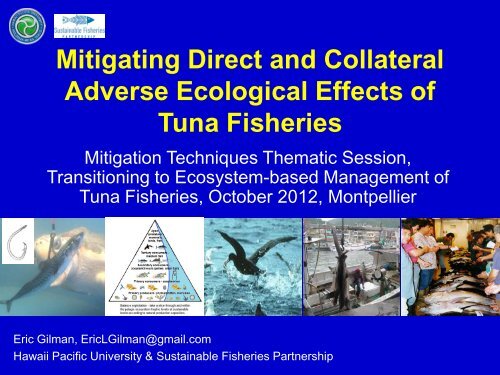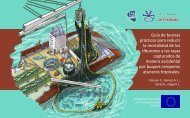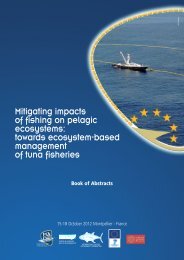Bycatch - Towards ecosystem-based management of tuna fisheries
Bycatch - Towards ecosystem-based management of tuna fisheries
Bycatch - Towards ecosystem-based management of tuna fisheries
Create successful ePaper yourself
Turn your PDF publications into a flip-book with our unique Google optimized e-Paper software.
Mitigating Direct and Collateral<br />
Adverse Ecological Effects <strong>of</strong><br />
Eric Gilman, EricLGilman@gmail.com<br />
Tuna Fisheries<br />
Mitigation Techniques Thematic Session,<br />
Transitioning to Ecosystem-<strong>based</strong> Management <strong>of</strong><br />
Tuna Fisheries, October 2012, Montpellier<br />
Hawaii Pacific University & Sustainable Fisheries Partnership
• Objectives <strong>of</strong> governing bycatch and collateral effects<br />
• Methods to mitigate bycatch <strong>of</strong> species groups relatively<br />
vulnerable to <strong>fisheries</strong> overexploitation, focusing on gear<br />
technology approaches<br />
• Estimating, accounting for and mitigating indirect, broader,<br />
community-level effects <strong>of</strong> fishing operations<br />
• Performance <strong>of</strong> <strong>tuna</strong> RFMOs in governing bycatch, and in<br />
transitioning to an <strong>ecosystem</strong> approach to <strong>fisheries</strong><br />
<strong>management</strong><br />
• Priorities for bycatch R&D and filling governance deficits
<strong>Bycatch</strong><br />
<strong>Bycatch</strong>: Retained non-targeted catch + discards + unobservable mortalities<br />
(ghost fishing, pre-catch, post-release, collateral, cumulative, synergistic).<br />
Responsible <strong>fisheries</strong> conduct requires the effective governance <strong>of</strong> all<br />
sources <strong>of</strong> fishing mortality, including from bycatch.
Ecological Objectives <strong>of</strong><br />
Governing <strong>Bycatch</strong> and Collateral<br />
Effects <strong>of</strong> Fishing<br />
Aim - do not increase <strong>ecosystem</strong> susceptibility <strong>of</strong> exceeding regime<br />
shift tipping points nor compromise sustained <strong>ecosystem</strong> services.<br />
Main ecological objectives:<br />
• Sustainably produce maximum multispecies yields <strong>of</strong> market species.<br />
• Mitigate bycatch <strong>of</strong> species relatively vulnerable to <strong>fisheries</strong><br />
exploitation - to avoid causing population-level declines and allow<br />
rebuilding and recovery.<br />
• Minimize indirect and broader effects, e.g., altering community and<br />
food web structure and processes (e.g., selective fishing), reducing<br />
diversity (e.g., loss <strong>of</strong> phylogenetically distinct species) and altering<br />
population evolutionary characteristics via selective gear.
Socioeconomic<br />
Objectives <strong>of</strong> <strong>Bycatch</strong><br />
Governance<br />
• Reduce waste from discards and unobservable losses.<br />
• Minimize fishing mortality <strong>of</strong> flagship species.<br />
• Minimize reductions in fishing communities’ revenue and<br />
food security from unsustainable bycatch mortality, including<br />
by managing the allocation <strong>of</strong> fishery resources subject to<br />
bycatch (through measures that meet scientific advice).<br />
• Reduce economic and operational inefficiency <strong>of</strong> catching<br />
and discarding unwanted species and sizes <strong>of</strong> catch.
Primary Sources <strong>of</strong> Tuna Products<br />
Purse Seine<br />
~1.7 million tonnes annually associated sets<br />
~~1 million tonnes annually free school sets<br />
Floating object sets supply predominantly skipjack; free<br />
school sets predominantly skipjack in the Pacific, yellowfin<br />
in the Indian & Atlantic; for canning<br />
Challenges & costs with tracing product to set type<br />
Longline<br />
~~650,000 tonnes annually<br />
Supplies fresh/frozen bigeye and yellowfin<br />
and albacore for canning<br />
Pole & Line<br />
~500,000 tonnes annually<br />
Supply predominantly skipjack for canning
Population-level <strong>Bycatch</strong> Problems in Tuna Fisheries<br />
SPECIES GROUP PELAGIC LONGLINE PURSE SEINE<br />
SEABIRDS In higher latitudes. NA<br />
SEA TURTLES In tropics and subtropics. Nominal population-level risk. Entangled<br />
in FADs & caught in pursed net.<br />
SHARKS Blue shark predominant. Silky & oceanic white tip predominant in<br />
associated sets (variable regionally).<br />
<strong>Bycatch</strong> <strong>of</strong> whale sharks and pelagic<br />
rays in targeted sets and inadvertently.<br />
<strong>Bycatch</strong> <strong>of</strong> manta rays in unassociated<br />
sets.<br />
MARINE<br />
MAMMALS<br />
JUVENILE &<br />
UNDERSIZED FISH<br />
Toothed whales. Isolated<br />
populations may be most<br />
at risk.<br />
Undersized swordfish;<br />
catch <strong>of</strong> juveniles is higher<br />
at seamounts.<br />
Sets on baleen whales can result in<br />
mortality. FAD and log sets occasionally<br />
result in cetacean and dolphin bycatch.<br />
Juvenile bigeye and yellowfin <strong>tuna</strong>s in<br />
associated sets – variable regionally.<br />
Gilman, E. 2011. <strong>Bycatch</strong> governance and best practice mitigation<br />
technology in global <strong>tuna</strong> <strong>fisheries</strong>. Marine Policy 35: 590-609.
Approaches to Reduce Unwanted<br />
<strong>Bycatch</strong> & Mortality<br />
• Input & Output Controls Limits on effort & catch<br />
• Gear Technology Modifications to fishing gear & methods<br />
• Changing Gear To reduce ecological risks, including from bycatch<br />
• Compensatory Mitigation E.g., <strong>of</strong>fset bycatch through predator control at<br />
nesting colonies – out-<strong>of</strong>-kind<br />
• Time/Area Restrictions Avoid predictable bycatch hotspots , e.g., at seamounts<br />
• Fleet Communication Communicate locations <strong>of</strong> real time bycatch hotspots<br />
• Industry Self-policing E.g., Alaska demersal LL fleet shares vessel-<strong>based</strong><br />
seabird bycatch levels<br />
• Handling and Release Practices To increase post-release survival rates<br />
• Gear Restrictions E.g., net mesh size, degradable gear<br />
• Gear Marking, Technology to Track Gear Position, Technology to Avoid Gear<br />
Contact w/ Seabed In part, to mitigate ghost fishing<br />
• Market-<strong>based</strong> Measures E.g., eco-labeling, buyer procurement specs,<br />
improvement projects
Mitigating Seabird – Longline <strong>Bycatch</strong><br />
Numerous highly effective<br />
gear technology methods<br />
to reduced seabird bycatch<br />
in LL <strong>fisheries</strong>.<br />
(Not shown - weighted<br />
branchlines, wider circle<br />
hooks).<br />
Night setting<br />
Tori Line Side setting<br />
Underwater<br />
setting<br />
Blue-dyed bait
Reducing Seabird <strong>Bycatch</strong> in the Hawaii<br />
Longline Tuna Fishery<br />
Gilman et al. 2008. Endangered Species Research 5(2-3): 309-323.
Molina et al. 2005. WCPFC SC1.<br />
Gilman et al. 2006. Fish and Fisheries 7: 2-23.<br />
Gilman et. 2007. Biological Conservation 139: 19-28.<br />
Chanrachkij et al. 2008. SEAFDEC.<br />
Mitigating<br />
Sea Turtle <strong>Bycatch</strong>
CPUE (number caught turtles per 1000 hooks)<br />
Nominal Turtle CPUE Pre- vs. Post- Regulations<br />
0.25<br />
0.2<br />
0.15<br />
0.1<br />
0.05<br />
0<br />
All turtle<br />
species pre<br />
regs<br />
All turtles Loggerhead Leatherback<br />
89.1%<br />
decline<br />
89%<br />
reduction<br />
89% reduction<br />
All turtle<br />
species post<br />
regs<br />
Loggerhead<br />
pre regs<br />
90.0%<br />
decline<br />
90%<br />
reduction<br />
90% reduction<br />
Loggerhead<br />
post regs<br />
Leatherback<br />
pre regs<br />
Gilman et al. 2007. Biological Conservation 139: 19-28.<br />
85%<br />
reduction<br />
Leatherback<br />
post regs
Mitigating LL & PS Shark <strong>Bycatch</strong><br />
• Use fish vs. squid for bait, reduces shark LL<br />
catch by ca. 30%.<br />
• Prohibit wire leaders (sharks remove<br />
terminal tackle).<br />
• Deeper setting.<br />
• Time <strong>of</strong> day <strong>of</strong> setting.<br />
• Chemical, magnetic, rare earth<br />
electropositive metals, & electrical<br />
deterrents – not cost effective.<br />
• PS FAD night sets may separate target<br />
from juvenile silky sharks<br />
• R&D in progress (Laurent Dagorn) on the<br />
use <strong>of</strong> attractants (lights, chemicals, chum)<br />
to separate target from shark species.<br />
Filmalter , Dagorn, et al. 2011. Bulletin <strong>of</strong> Marine<br />
Science 87: 325-337.<br />
Stoner & Kaimmer. 2008. Fisheries Research 92:<br />
162-168..<br />
Gilman et al. 2008. Marine Policy 32: 1-18.
Guillermo Compean, IATTC<br />
Mitigating Cetacean <strong>Bycatch</strong><br />
Hall et al. 2000. Marine<br />
Pollution Bull. 41: 204-219.<br />
Gilman et al. 2006. Marine<br />
Policy 30: 360-366.<br />
Gilman et al. 2006. Journal<br />
<strong>of</strong> Cetacean Research and<br />
Management 8(2): 215-223.<br />
Dolphins in purse seines: 98%<br />
reductions in direct dolphin<br />
mortality in EPO (where dolphins<br />
are commonly associated with<br />
<strong>tuna</strong>s) through annual mortality<br />
limits, backdown procedure (lower<br />
net below dolphins), Medina panel<br />
(fine mesh sewn into seine where<br />
conduct backdown) and deploying<br />
rescuers.<br />
Cetaceans on longlines: Circle<br />
hooks, ‘weak’ hooks, move<br />
location, fleet communication.<br />
R&D needed on deterrents,<br />
encasement, hydrophones, etc.
Gear Technology Mitigation <strong>of</strong> PS FAD<br />
<strong>Bycatch</strong> <strong>of</strong> Juvenile Tunas<br />
Rios and Sondheimer. 2011. MALAF, Ecuador.<br />
Nelson. 2004. SCTB17.<br />
More R&D needed on:<br />
• Towing FAD out <strong>of</strong> seine<br />
• Sorting grids<br />
• Separating target and unwanted<br />
species/sizes w/in the net<br />
• Depth <strong>of</strong> FAD appendage<br />
• Distinguish acoustic signatures<br />
or sounds<br />
• Stacked and paired FADs<br />
• Time <strong>of</strong> day <strong>of</strong> setting<br />
• Methods to increase pre-catch<br />
and post-release survival rates.
Longline Problematic <strong>Bycatch</strong> is Higher at<br />
Shallow Seamounts Relative to the Open Ocean<br />
Significantly higher sea turtle catch rate and larger proportion <strong>of</strong> catch<br />
comprised <strong>of</strong> juvenile <strong>tuna</strong>s at a shallow seamount relative to open ocean<br />
catches, Hawaii longline <strong>tuna</strong> fishery, 1994-2010 (Gilman et al., 2012).
State <strong>of</strong> Progress in Gear Technology <strong>Bycatch</strong> Mitigation<br />
SPECIES GROUP PELAGIC LONGLINE PURSE SEINE<br />
SEABIRDS Large number <strong>of</strong> effective methods<br />
(e.g., night setting, tori lines,<br />
underwater setting, side setting,<br />
branchline weighting).<br />
NA<br />
SEA TURTLES Wider hook, circle hook, large fish bait,<br />
set > 100m.<br />
SHARKS Fish instead <strong>of</strong> squid for bait, prohibit<br />
wire leaders, deeper setting. R&D on<br />
repellents.<br />
MARINE<br />
MAMMALS<br />
JUVENILE &<br />
UNDERSIZED<br />
FISH<br />
Circle hooks, ‘weak’ hooks. R&D on<br />
encasement, hydrophones, taste<br />
deterrents.<br />
Deeper setting, circle hooks, restricted<br />
use <strong>of</strong> lightsticks, avoid fishing at<br />
shallow submerged features.<br />
Avoid encircling turtles, monitor FADs,<br />
recover FADs when not in use, release<br />
when in net. R&D on modified FAD<br />
designs.<br />
R&D on separating sharks from FADs at<br />
night, attractants (lights, chemicals),<br />
repellents. Prohibit intentional sets on<br />
whale sharks, rays..<br />
Medina panel, backing down, deploy<br />
rescuers, day sets. Restrict setting on<br />
live whales.<br />
R&D on towing FAD out <strong>of</strong> seine, sorting<br />
grids, depth <strong>of</strong> FAD appendage,<br />
distinguish acoustic signatures, stacked<br />
and paired FADs.
Process Considerations for Effective Gear Technology<br />
Research & <strong>Bycatch</strong> Mitigation Interventions<br />
• Fishery-specific assessment: E.g., underwater setting<br />
in Hawaii vs. Australia.<br />
• Cooperative research: Industry knowledge and buyin.<br />
• Commercial viability: Limited surveillance and<br />
enforcement means effective methods will be<br />
employed only if they are safe, practical &<br />
economically viable – methods that don’t rely on<br />
crew behavior preferred.<br />
• Effects on multiple species groups: E.g., fish bait<br />
avoids turtles & sharks; night setting avoids<br />
albatrosses but not nocturnal foragers; circle hooks<br />
decrease turtle and seabird catch rates but increase<br />
shark catch rates.
Example – Holistic <strong>Bycatch</strong> Management –<br />
Relative Longline Risks to Sea Turtle and<br />
Shark Populations<br />
Catch rates on wider circle hooks significantly<br />
higher for <strong>tuna</strong>s and some pelagic sharks, and<br />
lower for sea turtles and billfishes, relative to<br />
narrower J-shaped hooks.<br />
Gilman et al. 2007. Biol Cons 139: 19-28.<br />
Gilman et al. 2012. Aquatic Cons<br />
Watson et al. 2005. CJFAS 62: 965-981.<br />
Blue shark
Indirect Ecological Effects <strong>of</strong> Pelagic<br />
Fisheries and Mitigation Methods<br />
Example – dFADs community-level effects & ecological trap hypothesis
Indirect Ecological Effects <strong>of</strong> Pelagic<br />
Fisheries and Mitigation Methods<br />
Example 2 – Community effects from fishery discharges
Indirect Ecological Effects <strong>of</strong> Pelagic<br />
Fisheries and Mitigation Methods<br />
Example 3 – Suboptimal school size
Transitioning to <strong>Bycatch</strong> Governance<br />
• Estimate and account for indirect<br />
effects <strong>of</strong> fishing mortality and<br />
unobservable losses.<br />
• Multispecies <strong>ecosystem</strong>-level<br />
models, indicators and reference<br />
points.<br />
• Balance fishing mortality across<br />
and w/in trophic levels at<br />
sustainable levels according to<br />
natural production capacities.<br />
• Marine spatial planning –<br />
integrated <strong>management</strong> <strong>of</strong> all<br />
sectors using marine resources.<br />
via EBFM<br />
Will t-RFMOs transition from the status quo <strong>of</strong> single-species stock assessments<br />
and biological reference points for a small proportion <strong>of</strong> incidental market bycatch<br />
species, and mixed progress in controlling bycatch <strong>of</strong> species and groups relatively<br />
vulnerable to overexploitation, to:
Tuna RFMO <strong>Bycatch</strong> Governance<br />
http://iss-foundation.org/rfmo-resolution-database/ - ISSF index to RFMO CMMs
Gilman, Passfield, Nakamura. 2012.<br />
Performance Assessment <strong>of</strong> <strong>Bycatch</strong> and<br />
Discards Governance by Regional Fisheries<br />
Management Organizations. IUCN.
Next Steps<br />
1. Continue invest in bycatch mitigation gear technology R&D.<br />
2. Address <strong>tuna</strong>-RFMO governance deficits:<br />
(i) Monitoring: meet scientific requirements for observer coverage rates,<br />
international exchange <strong>of</strong> observers, comprehensive data collection.<br />
(ii) ERA: Estimate & account for unobservable sources <strong>of</strong> fishing mortality.<br />
Assess collateral consequences <strong>of</strong> fishing operations.<br />
(iii) Controls: Fill gaps, adopt best practice gear technology, stipulate<br />
performance standards. Transition to <strong>ecosystem</strong>-level reference points<br />
and controls. Manage collateral effects.<br />
(iv) Surveillance, Enforcement, Sanctions: Surveillance sufficient to<br />
assess compliance, reporting, sanctions promote compliance,<br />
transparency.<br />
3. Augment market-<strong>based</strong> mechanisms to gradually improve fishing<br />
practices & governance.<br />
For more information:<br />
http://bit.ly/EGilman




